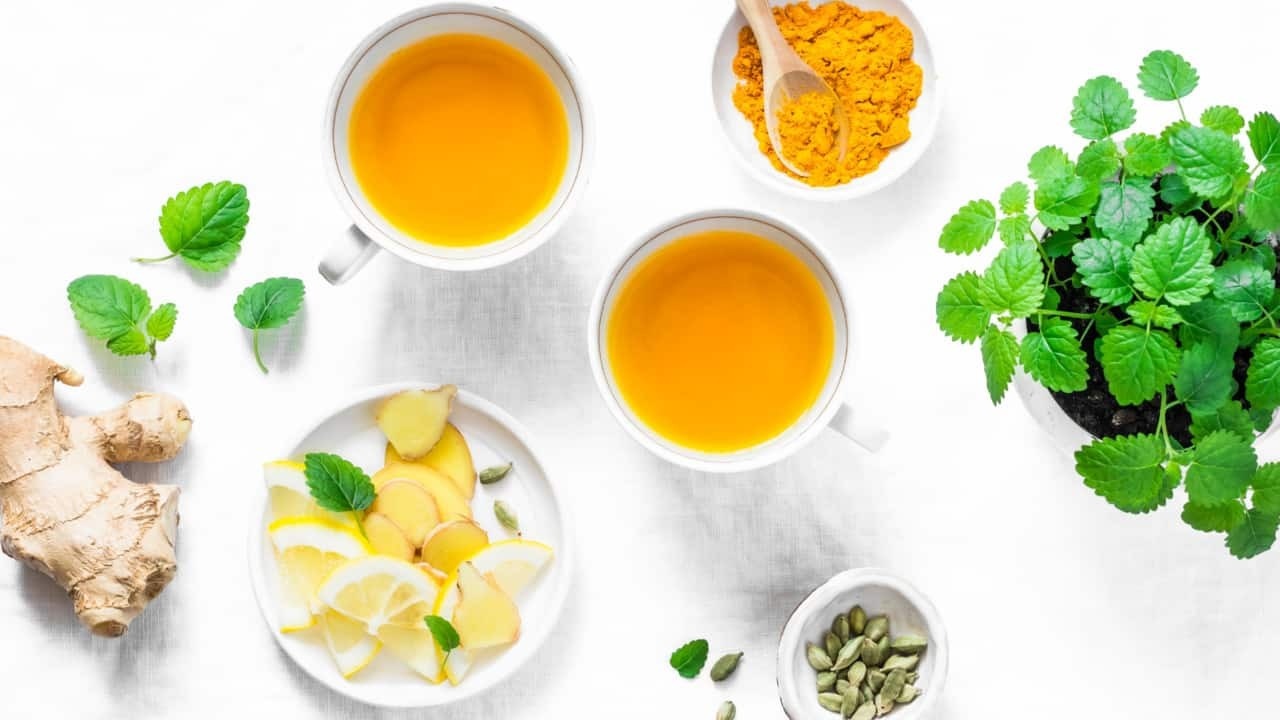KBW | My Top 5 Foods That Fight Inflammation Naturally

Do you have stiff joints, muscle pain, soreness, headaches, or migraines? These are all signs of inflammation in the body. Read on to check out my top 5 anti-inflammatory foods you can add to your diet to help fight inflammation naturally.
Anti-Inflammatory Foods
#1: Fatty fish
Fatty fish are a great source of the long-chain omega-3 fatty acids EPA and DHA. Your body metabolizes these fatty acids into compounds called resolvins and protectins, which have anti-inflammatory effects. EPA and DHA reduce inflammation that can lead to metabolic syndrome, heart disease, diabetes, and kidney disease. In fact, studies have found that people consuming salmon or EPA and DHA supplements experienced reductions in the inflammatory marker C-reactive protein (CRP). (Setty et al., 2019)
How to increase your Omega 3’s:
Although all types of fish contain some omega-3 fatty acids, these fatty fish are among the best sources:
- salmon
- sardines
- herring
- mackerel
- anchovy
#2: Turmeric
This is an orange-colored spice often used in curries and other Indian dishes. You may have heard of its active compound, curcumin. Thanks to curcumin, Turmeric has been proven to reduce inflammation related to arthritis, diabetes, and other diseases as well (Kocaadam et al., 2017).
How to increase your curcumin intake:
- Consuming turmeric with black pepper helps it to become more bioavailable, which means your body can use it easier. A recent study showed that consuming 1 gram of curcumin daily combined with black pepper caused a significant decrease in the inflammatory marker CRP in people with metabolic syndrome (Panahi et al., 2015).
- One of my favorite ways to get turmeric is in Organifi’s chocolate Gold. If you want to give it a try for yourself, use the code KBWellness for a discount on the turmeric-rich chocolate gold drink! And if you want to watch my video on how I use chocolate gold to make myself a delicious hot chocolate drink almost every night, stay tuned till the end of this video to check that out, and I’ll have it linked at the end!

#3 Cruciferous vegetables
These are rich in antioxidants and anti-inflammatory compounds like sulforaphane which will fight inflammation naturally by increasing ROS and depleting glutathione (Liang et al., 2018).
How to increase your cruciferous vegetables:
- Broccoli
- Cauliflower
- Brussels sprouts
- Kale
- Arugula
- Bok choy
- Collard greens
#4 Green tea
You’ve probably heard that green tea is one of the healthiest beverages you can drink, and it does a lot of amazing things for you, one of them being lowered inflammation thanks to the compound found in green tea called epigallocatechin-3-gallate (EGCG). EGCG inhibits inflammation by reducing pro-inflammatory cytokine production and damage to the fatty acids in your cells (Tipoe et al., 2007).

#5 Berries
Berries contain antioxidants called anthocyanins. These compounds have anti-inflammatory effects that may reduce your risk of disease (and they’re delicious, too!) (Fallah et al., 2019). Berries are great fresh or frozen, and frozen berries are the perfect addition to smoothies.
How to increase berry consumption:
-
Strawberries
-
Blueberries
-
Blackberries
-
Raspberries
-
Huckleberries
Putting it all together in your diet
So there you have it, five easy foods you can start to incorporate into your week. Simply aim for one to two cruciferous vegetables a day, throw some berries in your smoothie, drink green tea every morning and Organifi’s chocolate gold every night, add more fatty fish to your weekly meals, and you’ll be well on your way to reducing inflammation and reversing some of those aches and pains you may have been experiencing!
Want more help reducing inflammation and reclaiming your health and life? group coaching program, the KB Code

References:
Fallah AA, Sarmast E, Fatehi P, Jafari T. Impact of dietary anthocyanins on systemic and vascular inflammation: Systematic review and meta-analysis on randomised clinical trials. Food Chem Toxicol. 2020;135:110922. doi:10.1016/j.fct.2019.110922
Kocaadam B, Şanlier N. Curcumin, an active component of turmeric (Curcuma longa), and its effects on health. Crit Rev Food Sci Nutr. 2017;57(13):2889-2895. doi:10.1080/10408398.2015.1077195
Liang J, Jahraus B, Balta E, et al. Sulforaphane Inhibits Inflammatory Responses of Primary Human T-Cells by Increasing ROS and Depleting Glutathione. Front Immunol. 2018;9:2584. Published 2018 Nov 14. doi:10.3389/fimmu.2018.02584
Panahi Y, Hosseini MS, Khalili N, Naimi E, Majeed M, Sahebkar A. Antioxidant and anti-inflammatory effects of curcuminoid-piperine combination in subjects with metabolic syndrome: A randomized controlled trial and an updated meta-analysis. Clin Nutr. 2015;34(6):1101-1108. doi:10.1016/j.clnu.2014.12.019
Setty BNY, Betal SG, Miller RE, et al. Relationship of Omega-3 fatty acids DHA and EPA with the inflammatory biomarker hs-CRP in children with sickle cell anemia. Prostaglandins Leukot Essent Fatty Acids. 2019;146:11-18. doi:10.1016/j.plefa.2019.05.004
Tipoe GL, Leung TM, Hung MW, Fung ML. Green tea polyphenols as an anti-oxidant and anti-inflammatory agent for cardiovascular protection. Cardiovasc Hematol Disord Drug Targets. 2007;7(2):135-144. doi:10.2174/187152907780830905
Are you ready to start feeling better?
My team and I are here to partner with you on your health goals.
Find out more about working with us here ↓

